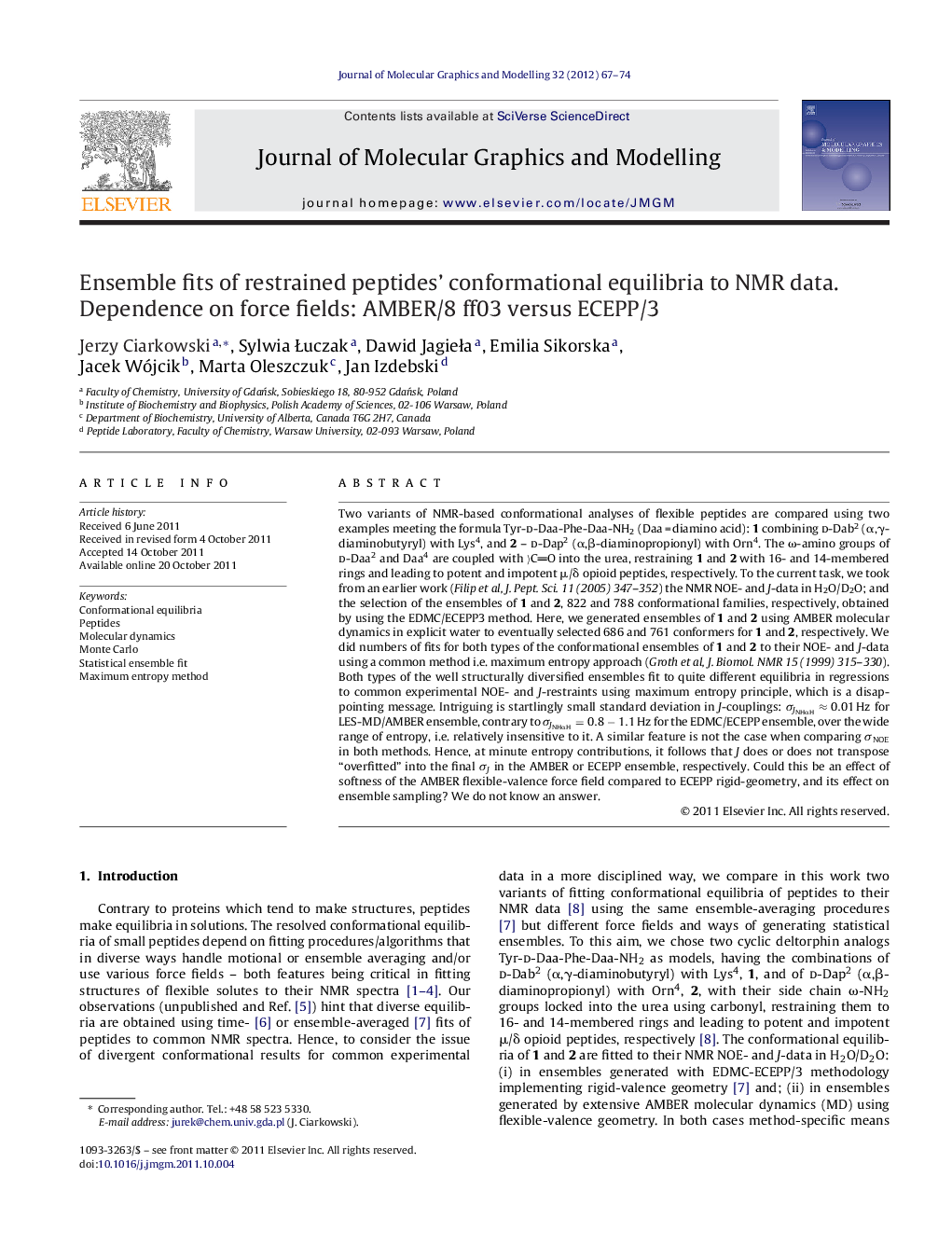| کد مقاله | کد نشریه | سال انتشار | مقاله انگلیسی | نسخه تمام متن |
|---|---|---|---|---|
| 443697 | 692752 | 2012 | 8 صفحه PDF | دانلود رایگان |

Two variants of NMR-based conformational analyses of flexible peptides are compared using two examples meeting the formula Tyr-d-Daa-Phe-Daa-NH2 (Daa = diamino acid): 1 combining d-Dab2 (α,γ-diaminobutyryl) with Lys4, and 2 – d-Dap2 (α,β-diaminopropionyl) with Orn4. The ω-amino groups of d-Daa2 and Daa4 are coupled with 〉CO into the urea, restraining 1 and 2 with 16- and 14-membered rings and leading to potent and impotent μ/δ opioid peptides, respectively. To the current task, we took from an earlier work (Filip et al, J. Pept. Sci. 11 (2005) 347–352) the NMR NOE- and J-data in H2O/D2O; and the selection of the ensembles of 1 and 2, 822 and 788 conformational families, respectively, obtained by using the EDMC/ECEPP3 method. Here, we generated ensembles of 1 and 2 using AMBER molecular dynamics in explicit water to eventually selected 686 and 761 conformers for 1 and 2, respectively. We did numbers of fits for both types of the conformational ensembles of 1 and 2 to their NOE- and J-data using a common method i.e. maximum entropy approach (Groth et al, J. Biomol. NMR 15 (1999) 315–330). Both types of the well structurally diversified ensembles fit to quite different equilibria in regressions to common experimental NOE- and J-restraints using maximum entropy principle, which is a disappointing message. Intriguing is startlingly small standard deviation in J -couplings: σJNHαH≈0.01 Hz for LES-MD/AMBER ensemble, contrary to σJNHαH=0.8−1.1 Hz for the EDMC/ECEPP ensemble, over the wide range of entropy, i.e. relatively insensitive to it. A similar feature is not the case when comparing σNOE in both methods. Hence, at minute entropy contributions, it follows that J does or does not transpose “overfitted” into the final σJ in the AMBER or ECEPP ensemble, respectively. Could this be an effect of softness of the AMBER flexible-valence force field compared to ECEPP rigid-geometry, and its effect on ensemble sampling? We do not know an answer.
Figure optionsDownload high-quality image (149 K)Download as PowerPoint slideHighlights
► Comparison between two conformational analyses of flexible peptides.
► Electrostalically driven MC ECEPP/3 (rigid-valence) or AMBER MD (flexible-valence) ensembles fitted to the experimental NOE- and J-data.
► Both well structurally diversified ensemble types fit to quite different equilibria.
► Ensemble from ECEPP appears poor by statistical measures.
► Taken standard deviation of JNHαH as a measure, indicates overfit in the LES-MD/AMBER and the lack of it in the EDMC/ECEPP3 ensembles, as their intrinsic properties.
Journal: Journal of Molecular Graphics and Modelling - Volume 32, February 2012, Pages 67–74